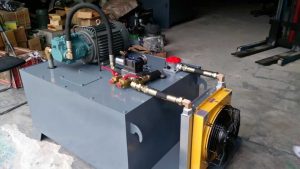Installation of Hydraulic Oil Coolers

Are you looking for suitable coolers for quenching and lubricating oils and heat transfer fluids? Hydraulic Oil Coolers is the answer for your needs. They are known to be ideally used to a spectrum range of manufacturing, agricultural, industrial and mobile settings. They are effective in removing excess heat which is generated by energy’s system losses as well as to external sources like furnaces, engines, and the surrounding environment.
Hydraulic Oil Coolers refers to the device specifically designed to prevent oil in the hydraulic system from overheating. Overheating of oil often lead to dropping of the system efficiency as well as to the excessive wear in the system components caused by a reduced oil viscosity. With the help of hydraulic coolers, oils are allowed to shed the accumulated thermal energy into a secondary medium.
This secondary medium typically involves air or water to where the thermal energy will pass the hot water via series of tubes into the constant flow of a low-temperature cooling medium. Thus, these cooling mediums can absorb the heat coming from the oil and then be carried away from the oil cooler.
Commonly, most of the known types of hydraulic oil coolers effectively work with the conductive transfer principle to where it see the heat in a single medium being conducted to another for particular removal and disposal.
Air coolers and water-based oil coolers are the two popular type of hydraulic oil coolers that are in general use and ideal in utilizing the air or water flow as a coolant medium. But before you go for hydraulic oil cooler installation, you have to determine which type is suitable for your requirements. Here, you will be able to learn the difference between water cooled air cooler and air cooled oil cooler.
Water Cooled Air Coolers
Water cool air coolers are commonly the tube and shell types. They involve a method for heat removal from the industrial equipment and components and is typically used as a heat conductor. Thus, they are commonly used for cooling various automobile internal combustion engines as well as huge industrial facilities like chemical plants, hydroelectric generators, and steam electric power plants.
If you choose water cooling oil coolers, you get several advantages. Since water is known to be non-toxic and inexpensive, you have the best opportunity to have high density, specific heat capacity, and thermal conductivity. This can effectively allow the water to transmit heat over the greater distances with the lesser volumetric flow and reduce the temperature difference.
Air Cooled Oil Coolers
Air cooled oil coolers are enclosed pipes in the sealed shell in which the cold water is circulated. They are used as a coolant in an engine oil and are intended for surplus heat removal from the internal combustion engine. Here, the hot engine efficiently transfers the heat onto the oil which passes through the heat-exchanger. Then, the cooled oil will flow back into the hot object for a continuous cooling process.
The same way to water cooling oil coolers, air cooling oil coolers can offer you certain advantages. Oil cooling oil coolers are known to have a high boiling point, meaning you can use them in order to cool items at least 100 degree Celsius or higher.
Also, they are good as electrical insulator where you can use them inside or even with direct contact with some of the electrical equipment like transformers. Since they are already in the form of lubricant, there is no need for additional pumps, radiators or tanks and they naturally help to prevent corrosion.
Safety on Hydraulic Oil Coolers
During the installation of hydraulic oil coolers, you have to be aware of the proper means for you to ensure complete safety. Thus, this will help you also in ensuring the effective use of the device and never install the filter with the outlet port.
- Transport and Storage
Keep in mind that you have to ensure that the heat exchanger is fully drained down based on the transportation. Next, it should be stored indoors while the connections need to be capped to avoid contaminants.
- Fitting
Make sure that the heat exchanger is free from signs of damage. Hydraulic oil coolers can be positioned either vertically or horizontally and then connected to the counterflow.
- Connecting Heat Exchanger
Here, you need to shut off all the drainage valves in the flow and return the pipes of the primary as well as secondary circuits. Remember, all the pipework materials need to be compatible with all the hydraulic oil cooler materials.
- Zinc Anode Notes
Zinc anode is used to prevent any brass alloy tube dezincification. Also, it acts as a sacrificially in the favor of the tube. Meaning, you are quite sure that the hydraulic coolers are characterized with strength and reliable use.
Whether you are opting water cooling or air cooling oil coolers, you have to ensure you are following the proper installation process. This can perfectly help you enjoy the benefits from hydraulic coolers and ensure low maintenance.

